Jewish Community Campus
 Call 911!
Call 911!
In case of an emergency at the Jewish Community Campus — the building that serves as the home of the Jewish Community Center and all its programming including the fitness center, Child Development Center, Heritage Center and the White Theatre; Hyman Brand Hebrew Academy; Jewish Federation; Jewish Community Relations Bureau/American Jewish Committee; Jewish Family Services; Midwest Center for Holocaust Education and a branch office of Jewish Vocational Services — its common sense to call 911 immediately. Last week, staffers and administrators from the agencies that are housed at the Campus met to learn more about keeping everyone safe.
Mark S. Shuster, chief financial officer of the Jewish Federation and a member of the Campus Crisis Management Team, pointed out that last week’s meeting wasn’t the first time anyone at the Campus has discussed safety issues.
"The Campus Crisis Management Team’s goal is to make being prepared an everyday task for everyone working at the Campus," Shuster said. "We work together to determine where we have gaps in preparedness for the group, and what the risks are for each agency."
Alan Bram, who has served as executive director of the Campus since before it opened its doors in 1988, explained that the Crisis Management Team, which includes representatives from all the agencies, works together to oversee all the crisis planning and training that goes on at the Campus. Bram said a crisis can be defined in many ways.
"A crisis can be any unplanned event, occurrence or sequence of events that can affect safety or security, financial stability, reputation or the ability to conduct normal business operations," he said. "Crises are characteristically uncommon, unpredictable and sometimes sudden, demanding immediate responses in order to save lives, avert secondary damage and restore normal operations."
Last week’s training session covered the topic of what to do if an armed intruder enters the building. But the Campus has emergency plans for a variety of crises, including fire, tornado, sudden illness/death, disorderly behavior, bomb threat, utility interruption, earthquake, lock down and evacuation.
As Bram points out, not every crisis requires an immediate response or threatens one’s safety.
"We schedule annual drills and evaluate what we learn from those drills about how well we are, or are not, prepared. Our training includes regular fire drills, and has included bomb detection and search training, evacuation, tornado and lock down drills, as well as CPR, first aid and defibrillator training. The Campus Crisis Management Team takes Campus security very seriously, every day," Shuster said.
"But there are some, like our exercise pointed out last week, that could threaten an institution’s survival," he said.
As Shuster pointed out, the Crisis Management Team meets regularly to review communication plans and establish contacts between organizations.
Last week’s training session was led by Adam Crowe, assistant director of community preparedness for Johnson County. Also in attendance to lend their expertise were Tim Lynch, the administrator of homeland security and emergency management for the Overland Park Police Department, and Roger Lippert, division chief of Johnson County Emergency Medical Services, commonly known as MED-ACT.
Crowe pointed out that the city and the county both maintain close relationships with all faith communities concerning safety issues, not just the Jewish Community Campus. That’s because law enforcement officials believe all faith communities are vulnerable to certain crisis situations.
He also pointed out during the training session that there is no absolute correct way to plan or train for an emergency, because "every emergency situation is going to be different."
OPPD’s Lynch said in certain emergency situations "all hands would be on deck." He elaborated by saying that law enforcement and emergency personnel from the surrounding areas — including Leawood, Prairie Village and the Johnson County Sheriff’s Department — would be at the scene as well as officials from Overland Park.
Lynch also told the group that even though they can’t ever feel like they are fully prepared for an emergency situation, sessions like the one they were attending are good.
"The planning and preparation is important and not a waste of time," he said.
Both Lynch and Bram said that the Campus has a great working relationship with the Overland Park Police Department.
In addition to planning meetings and drills, The Campus has five Automated External Defibrilators (AEDs) that have been used over the years that have saved five lives. A closed circuit TV system is also available that may help the police in case of an emergency situation.
Bram noted that while the Campus takes security and safety very seriously, no amount of planning and training will ever guarantee the safety of every student, every employee and every visitor in the building during a crisis situation.
"With sessions like we had last week, we are trying to do our very best to deal with, respond to and mitigate damage during a crisis situation," Bram said.



 "Discovering and Sharing Joy," Parts I and II, two exhibits by native Kansas City artist Rita Blitt on display this fall at Longview Community College and Penn Valley Community College, have this name for a reason. The drawings, paintings, sculptures and films reflect Blitt’s joy of life.
"Discovering and Sharing Joy," Parts I and II, two exhibits by native Kansas City artist Rita Blitt on display this fall at Longview Community College and Penn Valley Community College, have this name for a reason. The drawings, paintings, sculptures and films reflect Blitt’s joy of life. When Michael Grayman worked the footlights in Broadway as an assistant director on such productions as the revival of "Translations," he had a dream. As Andrew Parkhurst worked on his steps as the assistant choreographer for the Broadway production of "Curtains," he shared that dream. The two directed and performed on numerous productions from Broadway national tours to regional theaters, but for years they both came back to the idea of starting their own theater company.
When Michael Grayman worked the footlights in Broadway as an assistant director on such productions as the revival of "Translations," he had a dream. As Andrew Parkhurst worked on his steps as the assistant choreographer for the Broadway production of "Curtains," he shared that dream. The two directed and performed on numerous productions from Broadway national tours to regional theaters, but for years they both came back to the idea of starting their own theater company. 

 Rabbis in Kansas City are proud of the fact that across the board they get along well. Many will tell you it’s highly unusual for rabbis of very different spiritual beliefs — from Chabad to Reform to Orthodox — to support each other in one organization such as the Rabbinical Association of Greater Kansas City. The local rabbis want to take that support for each other a step further and begin finding ways for their congregations to collaborate more in an effort to build a more vibrant Jewish community for the future.
Rabbis in Kansas City are proud of the fact that across the board they get along well. Many will tell you it’s highly unusual for rabbis of very different spiritual beliefs — from Chabad to Reform to Orthodox — to support each other in one organization such as the Rabbinical Association of Greater Kansas City. The local rabbis want to take that support for each other a step further and begin finding ways for their congregations to collaborate more in an effort to build a more vibrant Jewish community for the future.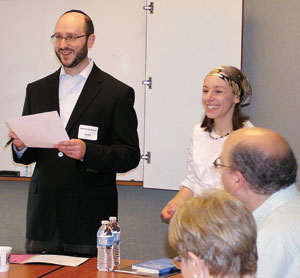 There are several collaborative ventures already taking place. For example, beginning this fall Beth Shalom and Beth Torah entered into an agreement that allows Beth Torah families to enroll their children at Beth Shalom’s preschool at a reduced rate. As part of the agreement, Beth Torah’s Rabbi Vered Harris now has an official presence at the preschool.
There are several collaborative ventures already taking place. For example, beginning this fall Beth Shalom and Beth Torah entered into an agreement that allows Beth Torah families to enroll their children at Beth Shalom’s preschool at a reduced rate. As part of the agreement, Beth Torah’s Rabbi Vered Harris now has an official presence at the preschool.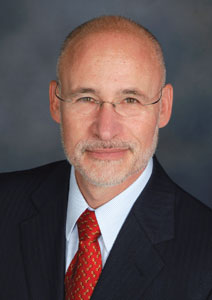 In the spirit of cooperation and collaboration, the two largest Reform congregations in town —The Temple, Congregation B’nai Jehudah and Congregation Beth Torah — will worship together for the first time at 6 p.m. Friday, Sept. 30, at B’nai Jehudah. The service will follow B’nai Jehudah’s ritual and, at the invitation of B’nai Jehudah’s Rabbi Arthur Nemitoff, Beth Torah’s Rabbi Mark Levin will give the sermon.
In the spirit of cooperation and collaboration, the two largest Reform congregations in town —The Temple, Congregation B’nai Jehudah and Congregation Beth Torah — will worship together for the first time at 6 p.m. Friday, Sept. 30, at B’nai Jehudah. The service will follow B’nai Jehudah’s ritual and, at the invitation of B’nai Jehudah’s Rabbi Arthur Nemitoff, Beth Torah’s Rabbi Mark Levin will give the sermon.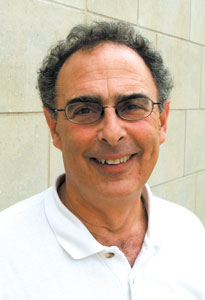 Rabbi Levin points out that the congregations, as well as the entire Jewish community, are very different than they were two decades ago.
Rabbi Levin points out that the congregations, as well as the entire Jewish community, are very different than they were two decades ago.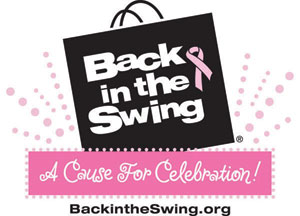 Just as a caterpillar spins her cocoon and slowly changes into a beautiful butterfly, Back in the Swing is undergoing a major metamorphosis as it emerges from its first decade of retail therapy and enters its second decade with a revised program of parties and learning.
Just as a caterpillar spins her cocoon and slowly changes into a beautiful butterfly, Back in the Swing is undergoing a major metamorphosis as it emerges from its first decade of retail therapy and enters its second decade with a revised program of parties and learning. Today (Thursday, Sept. 22) is Ann and Isak Federman’s 65th wedding anniversary. The two moved to Kansas City only months before they married. Coming to the center of the Midwestern United States is still one of Ann’s most treasured memories of their 65-plus years together.
Today (Thursday, Sept. 22) is Ann and Isak Federman’s 65th wedding anniversary. The two moved to Kansas City only months before they married. Coming to the center of the Midwestern United States is still one of Ann’s most treasured memories of their 65-plus years together. Ann Warszawski Federman is from Bendzin, Poland. In 1942 she was sent to a labor camp in Czechoslovakia along with her sisters, Gertrude and Lola. Ann was 20 when she was liberated in 1945.
Ann Warszawski Federman is from Bendzin, Poland. In 1942 she was sent to a labor camp in Czechoslovakia along with her sisters, Gertrude and Lola. Ann was 20 when she was liberated in 1945.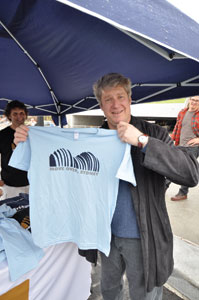 BRAVO — The opening events of the Kauffman Center for the Performing Arts were the talk of the town this weekend and early this week. It was designed by Israeli architect Moshe Safi, and the buzz is it’s magnificent. Many local Jews were involved in opening-weekend activities. One was Hyman Brand Hebrew Academy junior Avery Parkhurst, who plays violin in the Kansas City Youth Orchestra and performed Sunday in Helzberg Hall. Greg Azorsky had a booth outside the Kauffman Center during the open house Sunday selling one of his KC Cool shirts, which is an expansion of his Meshugge Shirts featured in the paper earlier this year. The design, “Move Over, Sydney,” sold well. Describing the design, Azorsky said that “the Sydney Opera House has been such an iconic building for the performing arts and now we have this new building here that may very well become another such building. I had a lot of people come up to our tent who said ‘That is just what I was thinking.’ ” Even Kansas City Symphony Music Director Michael Stern purchased a shirt! If you didn’t get a chance to see Kauffman Center last weekend, check it out when Marvin Hamlisch performs Nov. 3 in honor of the Midwest Center for Holocaust Education’s 18th anniversary.
BRAVO — The opening events of the Kauffman Center for the Performing Arts were the talk of the town this weekend and early this week. It was designed by Israeli architect Moshe Safi, and the buzz is it’s magnificent. Many local Jews were involved in opening-weekend activities. One was Hyman Brand Hebrew Academy junior Avery Parkhurst, who plays violin in the Kansas City Youth Orchestra and performed Sunday in Helzberg Hall. Greg Azorsky had a booth outside the Kauffman Center during the open house Sunday selling one of his KC Cool shirts, which is an expansion of his Meshugge Shirts featured in the paper earlier this year. The design, “Move Over, Sydney,” sold well. Describing the design, Azorsky said that “the Sydney Opera House has been such an iconic building for the performing arts and now we have this new building here that may very well become another such building. I had a lot of people come up to our tent who said ‘That is just what I was thinking.’ ” Even Kansas City Symphony Music Director Michael Stern purchased a shirt! If you didn’t get a chance to see Kauffman Center last weekend, check it out when Marvin Hamlisch performs Nov. 3 in honor of the Midwest Center for Holocaust Education’s 18th anniversary. Eric Korsten simply loves bees.
Eric Korsten simply loves bees. A package of 12,000 bees, Korsten explained, usually grows into a community of as many as 50,000. Each hive is a family with its own queen. A first-year hive might produce just a “shmear” of honey. As much as 250 pounds of honey can be extracted from a mature hive. Once the honey is extracted, the beeswax is spun, filtered and screened, before it can be jarred and ready for distribution.
A package of 12,000 bees, Korsten explained, usually grows into a community of as many as 50,000. Each hive is a family with its own queen. A first-year hive might produce just a “shmear” of honey. As much as 250 pounds of honey can be extracted from a mature hive. Once the honey is extracted, the beeswax is spun, filtered and screened, before it can be jarred and ready for distribution.